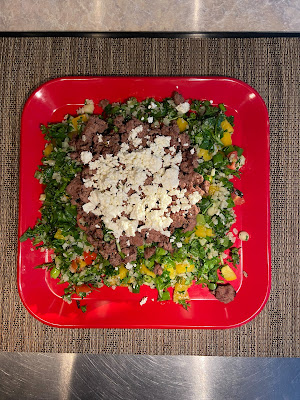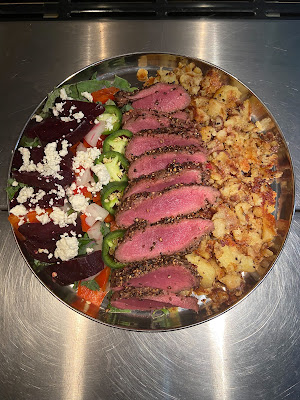Read all about writer Brandon Weaver’s first deer hunt in the November issue of Texas Parks & Wildlife magazine, then try out these incredible recipes yourself.
Ground Venison Mediterranean Bowl
“Herbs and game go so nice together,” says Chef Jesse Griffiths of Dai Due in Austin. He likes bright green herbs like mint, cilantro, parsley and dill.
Inspired by Griffiths’ recommendation, I combined the great flavor of ground venison with tabouli, a classic Mediterranean salad. It’s the perfect pairing.
I take the traditional tabouli recipe and add a little gluten-free twist. I replace the bulgur wheat, traditionally found in the dish, with riced cauliflower. The version has a really nice crunch and is hearty enough for a cold day.
Serves two hungry people or four folks saving room for dessert.
Tabouli Salad
4 cups finely chopped baby kale or baby arugula
3 cups finely chopped parsley
1 yellow bell pepper, diced
14 sweet grape tomatoes, cut into halves (any small tomato will do)
1 bunch green onions, sliced from white to green
1 cup chopped fresh mint
4 to 6 cloves pressed garlic
1 lemon
1 - 14 oz. bag of riced cauliflower (I like the H-E-B Caulibits)
2-3 Tablespoons extra-virgin olive oil
½ cup crumbled feta
Set oven on warm. Combine veggies (except cauliflower) in an oven-safe bowl or dish. Add two tablespoons of olive oil and squeeze the lemon over the top. Toss the ingredients, mixing thoroughly. Pour a thin layer of olive oil in a skillet and sauté the riced cauliflower and garlic over medium heat until cauliflower is crisp and garlic is slightly browned. Add fresh ground salt and pepper to taste; pour over veggie mixture and toss. Place the bowl in the warm oven.
Ground Venison
1 pound of ground venison
Processors, both commercial and home, add beef fat to ground venison. When you cook it, there’ll be a lot of excess fat. Sauté venison in a skillet with just enough avocado oil to keep it from sticking. I pour off about ¾ of the excess fat and set it aside. Add fresh ground salt, pepper and cumin to taste. When you add the seasoning, it’ll start to dry out so add back some fat to keep everything moist.
Plating
Use a shallow bowl or a plate with a lip for this dish, so you can mix everything up evenly. Take the warmed tabouli salad out of oven and fill your plate or bowl. It’s all veggies, so don’t be stingy! Add some ground venison and top with feta. I like to spice it up with Yellowbird Habanero sauce or El Yucateco Green Chile Habanero Sauce. Enjoy!
Peppercorn Crusted Venison Backstrap with Kale and Beet Salad
Keep the game-cooking process very simple, so the venison is the star of the show. Coat a six-inch piece of backstrap with avocado oil, coarsely cracked peppercorns and a little salt, and sear it on a hot grill. Per Chef Tre Wilcox’s recommendations, I let the meat rest for the same amount of time as it is cooked.
The following is my recipe for peppercorn crusted backstrap with pan-fried potatoes and a beet and kale salad. Since the venison is local, I try to source most of my veggies from my local farmer’s market, too. Eat fresh! Eat like a locavore, a person who eats food grown or produced locally.
Serves two hungry carnivores.
6- to 8-inch piece of backstrap cut lengthwise. I like a 2-inch thick steak so the meat cooks fast without drying out.
8 medium red potatoes, cut into quarters, boiled
8 oz. bag of baby kale. Use half of the bag and save the rest for the Ground Venison Mediterranean Bowl.
1 large beet, either oven-roasted or boiled. Cut the cooked beet in half and then slice the halves.
1 red bell pepper, diced
1 jalapeño pepper, sliced (optional)
1 bunch green onions, sliced from white to the green
½ cup crumbled feta cheese
4 to 8 cloves pressed garlic
¼ cup avocado oil
¼ cup extra-virgin olive oil
I set the meat and veggies out as I cook the potatoes, so everything comes to room temperature.
I’ve had myriad fancy pepper grinders and they all break. The H-E-B Peppercorn Medley Grinder is my go-to seasoning apparatus. You can even unscrew the top and refill it. I generously coat the entire backstrap filets with peppercorn. I’ll salt it after it comes off the grill.
Preheat the grill on high. You want it hot!
Pan-Fried Red Potatoes
Heat ¼ cup of avocado oil in a skillet over medium-high heat. Drain cooked potatoes and smash with a spatula, then add to the skillet. If the oil starts to smoke, turn down the heat. Cook four to six minutes until a golden crust develops. Season with salt, pepper and pressed garlic; add olive oil as needed to keep a light fry going. Flip to brown the other side. Once they’re crisp, add a little more salt and pepper to taste and keep warm in the oven.
Kale Salad
Chop the baby kale, making several crosscuts so the leaves are bite-size. I plate it to the side of the dish and add red bell pepper and green onion. I’m looking for color here, so the beets and jalapenos go on last to complete the rainbow.
Venison
Drop the backstrap on the hot grill and cook 60 to 90 seconds per side (err on the side of less). It’ll cook fast. Pull it off and add just a touch of fresh ground sea salt or my favorite pink Himalayan salt. Let it rest in a warm part of your kitchen so you get a nice medium-rare, warm center.
Final Presentation
Heat a thin layer of olive oil in a skillet over low heat. Plate the potatoes on the other side of your dish. Warm the sliced beets in the pan, then place them on the greens with some sliced jalapeños. Pour warm olive oil over the salad and finish with feta on top. Slice the backstrap and place down the middle to bridge your greens and potatoes. Enjoy!
If you want more content like this, subscribe to Texas Parks & Wildlife magazine. Whether in print or through our mobile app, choose the version that works best for you.







